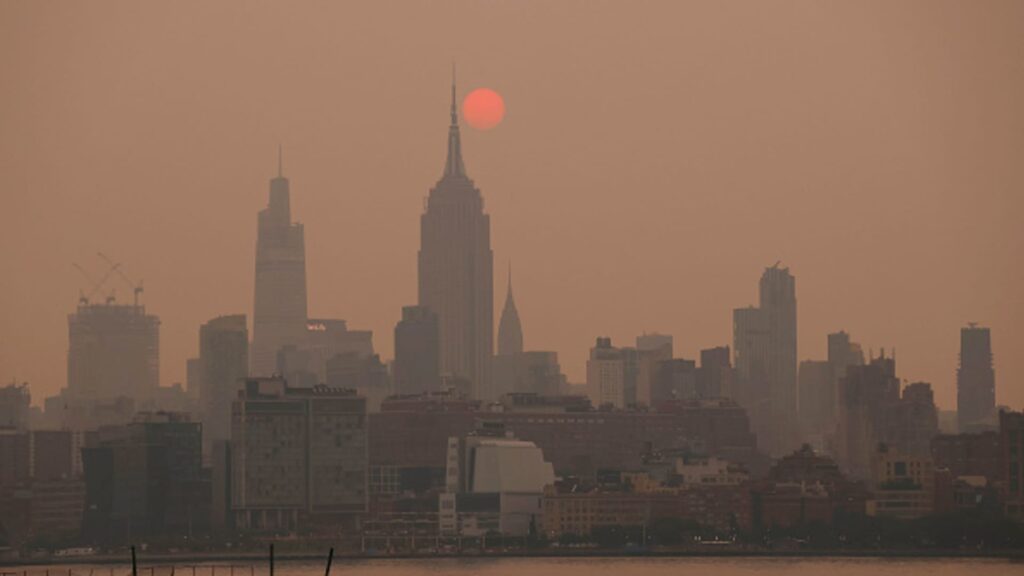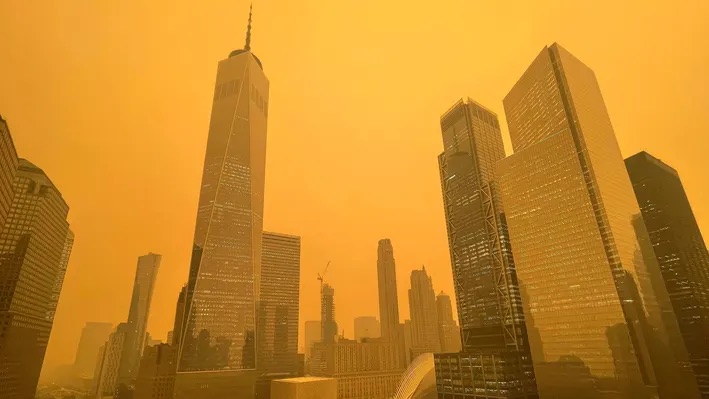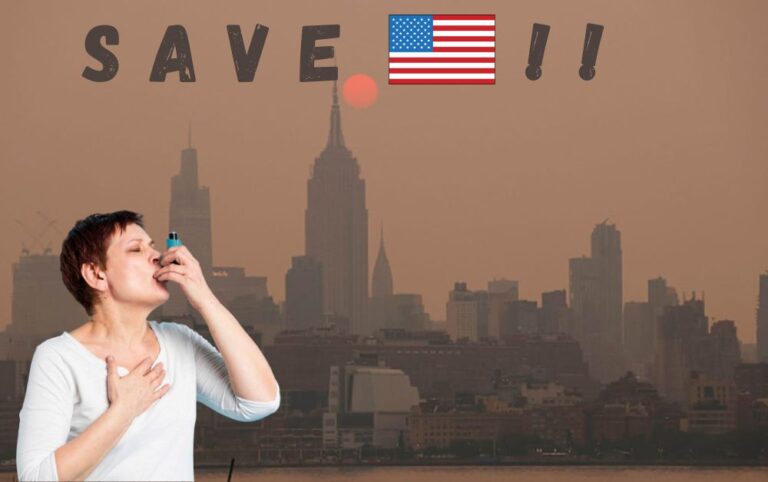
New York City is notorious for its vivacious energy, bulging streets, and distinctive skyline. still, the city has been covered in a heavy haze of smoke in recent weeks, egging alarm among locals and visitors likewise. The smoke is caused by wildfires blazing thousands of kilometers distant in the western United States.
While it may appear to be a distant issue, wildfire smoke has a substantial influence on the health of New Yorkers. In this article, we’ll look at how New York wildfire smoke affects your health, how you can cover yourself, home remedies for protecting yourself, a list of medical treatments, and why it’s critical to be apprehensive about this continuing environmental concern.
So, whether you are a long-time New Yorker or a first-time sightseer, keep reading to discover further about the implicit health concerns associated with New York City Haze.
As per the report published by USA Today , on Wednesday, fierce wildfires in Canada’s western provinces persisted, prompting smoke to move south and triggering air quality alerts across the US.
U.S. authorities claim that Maryland, Baltimore, Virginia, and Pennsylvania have all been reached in the south by the smoke that has been carried by the wind. Tuesday saw the Environmental Protection Agency issue a bad air quality advisory for New England, following the day before’s similar alerts for sections of Illinois, Wisconsin, and Minnesota.
Adrianna Rodriguez. USA Today.
Understanding the Health Effects of New York Wildfire Smoke
Wildfire smoke is made up of a complex mixture of gases and fine particles that can be dangerous to your health. These bitsy particles, known as particulate matter(PM), can range in size from lower than 0.1 microns to 10 microns.
When gobbled, these particles can access deep into your lungs and indeed enter your bloodstream, causing a range of health problems.
The health effects of wildfire fume depend on a number of factors, including the duration and intensity of exposure, the person’s age and health state, the size and composition of the particulate matter, and other factors.
Short-term exposure to wildfire smoke can beget eye, nose, and throat irritation, coughing, and shortness of breath. Long-term exposure to wildfire smoke can increase the threat of respiratory infections, heart disease, and lung cancer.
It’s important to note that the health effects of wildfire smoke can be particularly severe for certain groups of people, including children, seniors, pregnant women, and individuals with pre-existing respiratory or cardiovascular conditions.
The Link Between Canada and New York
As per the data presented by Global Affairs Canada, Canada, and New York are geographically linked through their close proximity and the presence of a participated border. New York is positioned along the northeastern border of the United States, which is conterminous to Canada in the north. The Canada- United States border stretches over 8,891 kilometers( 5,525 long hauls), making it the longest transnational land border in the world.
The prevailing wind patterns in the region play a pivotal part in connecting Canada and New York in terms of atmospheric movement. The dominant wind patterns in this area are influenced by several factors, including the general rotation of the Earth’s atmosphere, temperature gradients, and the presence of natural geographic features similar to mountains and bodies of water.
During periods of wildfires or other sources of smoke in Canada, the prevailing wind patterns can transport the smoke particles toward the east, potentially reaching New York. However, the fume can be carried over long distances, If the winds are strong and patient. still, the transport of fume is also influenced by the stability of the atmosphere.
Weather systems such as low-pressure systems and frontal boundaries can also influence smoke transport. These systems can enhance or alter the prevailing wind patterns, affecting the direction and speed of the winds.
Weather systems similar as low- pressure systems and anterior boundaries can also impact smoke transport. These systems can enhance or alter the prevailing wind patterns, affecting the direction and speed of the winds.
How Wildfire Smoke Affects Your Respiratory System?

When you inhale wildfire smoke, it can irritate your respiratory system, causing inflammation and swelling in your lungs and airways. The particulate matter in the fume can also damage the delicate tissues in your lungs, making it harder to breathe and increasing your threat of respiratory infections.
Still, similar to asthma or habitual obstructive pulmonary disease( COPD), exposure to wildfire smoke can worsen your symptoms and increase your threat of complications If you have existing respiratory conditions. Children and seniors are also at increased risk of respiratory problems from wildfire smoke exposure.
I know how smoke affects our respiratory system because I have gone through that one. Back in November 2022, Earth’s sky was full of white polluted smoke, in which I was not able to breathe properly. As I was out for 2 days, I started experiencing problems with breathing, chest pain, and nose irritation. As smoke has a lot of polluted particles it can affect the human respiratory system in the worst manner that no one can predict.
Health Risks of Exposure to Wildfire Smoke
Exposure to wildfire smoke can have both short-term and long-term health pitfalls. Short-term exposure can beget eye, nose, and throat irritation, coughing, and shortness of breath. These symptoms generally go down formerly you’re no longer exposed to the smoke. still, long-term exposure to forest fire smoke can have more severe health consequences.
The particulate matter in the smoke can beget habitual bronchitis, reduced lung function, and indeed lung cancer. Long-term exposure can also increase the danger of heart disease and stroke.
Identifying Symptoms of Wildfire Smoke Exposure
If you have been exposed to New York wildfire smoke, it’s important to be aware of the symptoms of smoke exposure. These can include:
- Coughing
- Shortness of breath
- Wheezing
- Chest tightness or pain
- Headaches
- Sore throat
- Burning eyes
- Runny or stuffy nose
If you are experiencing any of these symptoms, it’s important to seek medical attention. Your doctor can help determine whether your symptoms are related to wildfire smoke exposure and provide treatment options to help alleviate your symptoms.
Who is Most Vulnerable to This New York Haze?
While wildfire smoke can impact anyone, certain groups of people are more vulnerable to the health effects of smoke exposure. These groups include:
– Children, especially infants and young children whose lungs are still developing.
– The elderly.
– Pregnant women.
– Individuals with pre-existing respiratory or cardiovascular conditions, such as asthma or COPD.
– Outdoor workers, such as firefighters or construction workers.
– Individuals who live in areas with high levels of air pollution.
If you fall into any of these categories, it’s very important that you take steps to protect yourself and your family members who also fall in the above list from wildfire smoke exposure.
Tips for Protecting Yourself from Wildfire Smoke
There are several steps you can take to protect yourself from wildfire smoke exposure. These include:
- Stay indoors as much as possible, with windows and doors closed.
- Use an air purifier with a HEPA filter to help remove smoke particles from the air.
- Avoid outdoor activities, particularly those that require exertion.
- Wear a mask or respirator rated N95 or higher if you must be outside.
- Keep indoor air clean by avoiding smoking or burning candles or incense.
- Take frequent breaks to rest and recover if you must work outdoors.
It’s also important to stay informed about the air quality in your area. You can check the air quality index (AQI) for your area on Google or on popular websites like The Weather Channel one of the best sources which I also use. Bingo! If the AQI is high, it’s best to stay indoors and avoid outdoor activities until the air quality improves.
Home Remedies for Dealing with Wildfire Smoke Exposure
If you are experiencing symptoms of wildfire smoke exposure, there are several home remedies that can help alleviate your symptoms. These include:
- Drinking plenty of water to help flush out toxins from your body.
- Using a saline nasal spray to help clear your nasal passages.
- Using a humidifier to help moisten the air and soothe respiratory tissues.
- Using over-the-counter medications such as antihistamines or decongestants to help alleviate symptoms.
While these remedies can be helpful in managing symptoms, it’s important to seek medical attention if your symptoms persist or worsen.
Medical Treatment for Wildfire Smoke Exposure
If you are experiencing severe symptoms from this New York wildfire smoke from Canada, your doctor may prescribe medications or other treatments to help alleviate your symptoms. These may include:
- Bronchodilators help open your airways and improve breathing.
- Corticosteroids reduce inflammation in your lungs and airways.
- Oxygen therapy to help improve oxygen levels in your blood.
- Antibiotics to treat respiratory infections.
In severe cases, hospitalization may be necessary to provide supportive care, such as intravenous fluids and oxygen therapy.
Conclusion
Although the wildfire smoke in New York City may appear distant, its impact on the health of original residents is significant. Being exposed to this smoke can lead to colorful health issues, ranging from eye irritation and coughing to habitual bronchitis and lung cancer.
It’s pivotal to take preventative measures to shield oneself from smoke exposure, similar to staying outdoors, exercising with air disinfectants, and wearing masks. However, seeking medical attention and clinging to your doctor’s advice for treatment is vital, If you witness symptoms associated with smoke exposure. By staying informed and taking visionary ways to guard your well-being, you can minimize the adverse effects of wildfire smoke.
Frequently asked questions
Where is the wildfire smoke in New York coming from?
This New York Wildfire smoke is coming from Canada because of the prevailing wind patterns in the region which play a pivotal part in connecting Canada and New York in terms of atmospheric movement.
Does New York have wildfires?
Yes, New York Have severe wildfires coming from Canada since Wednesday, leading to zero visibility and a smoky environment for New Yorkers.
How bad is the air quality in NY?
The air quality reached levels beyond hazardous in several cities upto 500 because of this New York Haze.
does new york have good air quality?
According to IQAir, New York is one of the most polluted cities in the United States surpassing even New Delhi, India. In terms of hazardous PM2, Air quality is much better i

